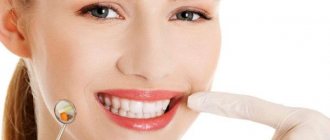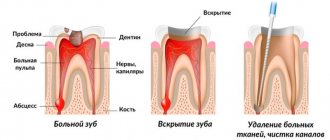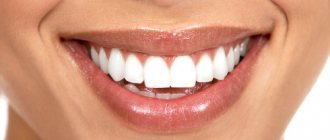Causes What to do about pain?
Home Remedies Dental Care Prevention Having completed treatment, we leave the dentist's office with a feeling of relief. Then the effect of local anesthesia ends and it is discovered that the tooth hurts after the filling. There is no reason to panic and immediately make an appointment. Pain is a natural reaction to medical intervention:
- To prepare a tooth, it is drilled. Nerve endings in hard tissue react to this process by sending pain signals to the brain. The deeper the drill went, the more painful it was.
- When the pulp (nerve) is removed, adjacent vessels and nerve endings are injured.
- The antiseptic used to treat the cavity has a strong irritant effect. It can get into surrounding tissues, causing discomfort.
This kind of pain goes away on its own within up to 2 weeks.
. The main feature: the unpleasant sensations gradually subside and disappear.
What else causes toothache under a filling?
Sometimes, the tooth continues to hurt or causes discomfort. This may be caused by medical error:
- The dentist overdried the dentin, causing a burn. The tooth reacts to temperature stimuli and tapping.
- Dentin was not dried enough. An air gap with negative pressure appears between the filling and the wall, which causes pain.
- When treating deep caries, the doctor damaged the pulp chamber, pathogens penetrated into the pulp and caused inflammation - pulpitis.
- The filling was placed incorrectly; it irritates the gums, causing swelling, redness, and pain.
A broken instrument, too much or too little filling material, allergic reactions to its composition also lead to unpleasant sensations.
Pain after treatment of PERIODONTITIS.
Sometimes it happens that the tooth never hurt, but the doctor diagnosed periodontitis and treated it, after which the tooth began to bother. In such a situation, do not rush to blame the doctor and believe that he provided poor-quality treatment.
Treatment of periodontitis is a very complex process that cannot promise guaranteed success. After all, periodontitis is an accumulation of microbes outside the tooth root (in the bone tissue). If before treatment microbes moved freely from the oral cavity to the tooth root and back, then after filling the canals, the bacteria remaining in the bone tissue are “immured.” Normally, this manipulation allows you to localize the source of infection, after which it is easier for the body to cope with it and “defeat” the microbes.
However, with a weakened immune system, due to the individual characteristics of the body, inflammation and a pain reaction may occur in response to sealing of the channels. Even if the tooth did not bother you before, now it can react to pressure and touching it; there may be pain when biting, throbbing, or a slight aching pain in the tooth.
Abnormalities include sharp, paroxysmal pain, the inability to close teeth due to pain, swelling of the gums or cheeks around the tooth, the appearance of tooth mobility, deterioration in general health, or a significant increase in body temperature.
In any case, if pain occurs, it is better to consult a doctor. Additional manipulations or the prescription of certain medications may be required. However, don't panic! Sometimes this kind of pain goes away on its own after some time.
What to do if your tooth hurts after installing a filling?
You should pay attention to the nature of the pain. If it is aching, tolerable, and is not associated with food intake, then the chances are high that everything will work out on its own.
You should worry if:
- The pain is throbbing, increases towards night, the sealed tooth with the nerve hurts - this indicates inflammation of the pulp.
- Unpleasant sensations appear only when biting or pressing on the filling - most likely, the filling technology is broken.
- There is a feeling that the tooth is sticking out, there is discomfort when chewing - the filling is too large.
- The mouth burns, the gums hurt, the mucous membrane turns red and swells - signs of an allergic reaction.
- The pain does not decrease, but may intensify. The gums swell, general malaise appears, and the temperature rises. These symptoms indicate that periodontitis is developing.
Pain after CARIES treatment.
Normally, slight pain may occur when pressing on the filling.
, when a hard piece of food gets on the tooth while eating, or when running a fingernail or toothpick over the filling. Painful sensations more often occur after treatment of deep caries: the bottom of the carious cavity is close to the “nerve” of the tooth, and the placed filling, when pressed on it, transfers pressure to the tooth pulp. Over time, these pain sensations will decrease, because... The tooth pulp will develop a protective layer of dentin and “fence itself off” from the filling. However, this takes some time, and the discomfort when biting on a tooth can last up to several months.
Slight dull pain
in a tooth it can also be quite normal. In some patients, this is an individual reaction of the tooth to the doctor’s intervention (mechanical treatment of the tooth with burs, medicinal treatment with antiseptics, “exposure” of the filling with a halogen lamp, etc.). Such pain should not persist for more than 7–14 days.
Acute pain is not considered normal
, spontaneous (causeless) attacks of aching pain, especially at night. If you experience similar sensations after caries treatment, you should consult a doctor for an examination and, possibly, additional procedures.
If the filling is located in the cervical part of the tooth (near the gum), then the tooth may react to temperature stimuli
. In this case, it is important to pay attention to whether there is an overhanging edge of the filling in the gum area (i.e., a step or gap between the edge of the filling and the tooth). If such an unevenness exists, it can injure the edge of the gum, the gum can become inflamed and expose the root of the tooth. And, as you know, the root of the tooth is not covered with enamel and is very sensitive to any irritants. Therefore, if you notice that after treatment of cervical caries or wedge-shaped defect, the gums of the tooth become inflamed, and the tooth reacts to cold or sweet foods, then consult a doctor immediately.
How to help yourself at home
All home remedies that are recommended for use if a tooth aches under a filling reduce the symptoms, but do not eliminate the cause. These measures are temporary and are applied until you see a doctor. The only exception is natural pain after a filling has been placed.
Pharmacy painkillers will help you relax and sleep. Rinsing with salt or soda relieves irritation. Infusions of herbs, calendula, chamomile, and sage have a disinfectant and anti-inflammatory effect.
Modern dentistry has a negative attitude towards such traditional medicine as a hot compress. This can increase inflammation, cause bleeding and a purulent process.
Pain after REMOVAL of a “NERVE” from a tooth (after treatment for PULPTIS).
Quite often, so-called “post-filling” pain occurs after tooth depulpation. Mild pain when pressing on a tooth is considered normal.
and tapping on it, lasting no longer than 4–8 weeks. This is due to the fact that during the treatment process the doctor performs mechanical treatment of the root canals with metal instruments and rinses the canals with powerful antiseptics. All this can irritate the tissue surrounding the root. The reaction to such influences is different for all patients.
If the pain when biting on a tooth is sharp, severe, there is a feeling of an “overgrown” tooth, swelling of the gums or cheeks around the tooth appears, general health worsens or body temperature rises - this is a reason to immediately consult a doctor. Complications of endodontic treatment may have arisen that need to be addressed.
Treatment in dentistry
If you experience severe, increasing pain, you should immediately consult a doctor. Also, you should make an appointment if your tooth ache after filling, although about 2 weeks have passed. The dentist will conduct an examination and order an x-ray examination. An examination will determine whether the filling is in the way. If so, the doctor will simply sand the surface.
The picture will show what causes discomfort:
- periodontal inflammation;
- pulpitis;
- tool fragment.
In this case, the tooth will have to be refilled. The old filling is removed and the reason why the filled tooth aches is eliminated. The duration of treatment depends on the severity of the defect. A piece of the tool can be removed in one go. Severe inflammatory processes will require several visits and endodontic intervention when the canals are re-treated.
If, after installing a filling, a tooth hurts as a result of an allergy to the material, it is replaced using a different composition.
Causes of pain
After pulpitis, a tooth hurts for several reasons - damage to the tissues surrounding the tooth root (periodontal) or an inflammatory process.
Tissue damage can be caused by the following circumstances:
- formation of a wound surface during removal of the neurovascular bundle of a tooth;
- treatment of root canals with antiseptic agents if the antiseptic leaves the canal.
Can a tooth hurt after pulpitis due to the dentist’s dishonest work? The inflammatory process can occur due to poor quality work by the doctor. Signs of poor treatment of pulpitis on an x-ray are:
- incomplete filling of root canals, when there is still free space left to the apex;
- excessive filling of root canals, when the filling material extends beyond the apex of the root canal;
- extra holes in the root canals.
Memo for patients
- Do not delay visiting your doctor if there are signs of an allergic reaction.
- If the pain increases, swelling, redness, or fever appears, make an emergency appointment
- Do not relieve pain with antibiotics unless prescribed by a doctor.
- Do not use alcohol or garlic applications, as they can burn the mucous membrane.
- Never heat your tooth
- Follow all dentist recommendations
A qualified doctor, a clinic with modern digital equipment and following the recommendations will help you avoid situations where a tooth hurts after installing a filling.
Expert of the article Bolshakova Evgenia Vladimirovna Dentist-hygienist
More than 11 years of experience
When there is no need to see a doctor
Why does a tooth hurt after pulpitis? The appearance of pain is due to the increased trauma of the entire procedure, which consists of opening the tooth, removing pulp from the root canal and filling the empty space with artificial material - a filling.
How long does a tooth hurt after pulpitis in normal condition? Without pathologies, the pain persists for 5-10 days, and it gradually subsides. It is considered normal when:
- after pulpitis, the tooth hurts without increasing pain;
- there is no bleeding, swelling, swelling or redness, general weakness, or fever.
Potential Causes of Pain
In most clinical cases, the cause of pain and discomfort is medical error and non-compliance with treatment technology.
Possible reasons:
- Errors during the preparation of a carious area: overheating of the dentin, perforation of the bottom or wall of the carious cavity, breaking off the wall of the carious cavity, damage to neighboring teeth by the bur or damage to the gum edge on the neck of the tooth. What method can be used to correct the situation depends on the type of error made. As a rule, the tooth is re-treated and filled again.
- Violation of filling technology by a specialist.
- Incomplete grinding of the filling. In this case, the installed filling rises slightly above the walls of the tooth; when the jaws are closed and chewed, another tooth puts pressure on it. As a result, the filling puts pressure on the pulp, causing irritation of the nerve endings and pain. The pain can only be eliminated by additional grinding of the filling to the required size.
- Overdrying of the carious cavity. Before filling, the tooth walls are thoroughly dried with a stream of warm air. This is necessary so that the filling material is well secured and subsequently the filling does not fall out of the tooth. Excessive drying sometimes damages the nerve endings located in the surface layer of dentin. This causes pain and is fraught with the development of inflammation of the dental nerve. The correction method is removal of the filling, removal of the nerve and filling of the root canals, installation of a new filling.
- Insufficient drying of the carious cavity. In the presence of moisture, the filling is not firmly fixed to the walls of the tooth. As the filling material dries, it decreases in volume and the filling literally “lags behind” the walls. As a result, voids form between it and the walls of the tooth and irritation of the nerve endings occurs. After a short time, the filling usually falls out. The situation can be corrected with a new filling.
- Allergy to components in the filling - in this case, only new treatment using other materials will help. In addition to pain, allergies are accompanied by a rash, redness of the skin, swelling, and the gums at the treatment site may swell.
- Tissue infection followed by inflammation. During treatment, an infection enters the tooth cavity and provokes inflammation of the nerve endings. This process is called pulpitis. Its characteristic feature is severe acute pain, which occurs for no apparent reason and intensifies at night. In an advanced stage, pulpitis turns into periodontitis and provokes the formation of a cyst. Therefore, if acute, persistent pain appears, you should consult a doctor as soon as possible.
In most cases, a specialist’s mistake can be corrected without serious complications or consequences for the patient. The earlier the pathology is identified, the higher the likelihood of its successful elimination.
Pain after caries treatment is a fairly common phenomenon, and this is its insidiousness. Often, patients cannot recognize the presence of complications in time and turn to a specialist only when the complication reaches the acute stage and provokes concomitant diseases. Therefore, if pain occurs, it is better to consult a specialist once again than to endure and wait.
Periodontitis
A slight aching pain or pain when pressing on a tooth, which occurs after the end of the periodontitis treatment procedure, is considered normal and goes away on its own over time. If your gums or cheeks are swollen, you have paroxysmal pain, or your body temperature has risen, you should go to the hospital as soon as possible.
In our dental center in Brest you will receive qualified dental care both for caries, pulpitis and periodontitis, and for pain after dental intervention.
What can hurt a tooth?
A tooth consists of a root and a crown. It is covered as a frame with dentin and cement in the root area, dentin and enamel in the crown area. These are hard tissues that lack nerve endings, so they cannot hurt. Inside the tooth there is a space filled with tissue penetrated by branches of nerves. This is pulp. The pulp is also contained in the canals that connect the tooth cavity to the root. Any diseases (for example, inflammation - pulpitis) and injuries to the pulp are very painful.
Periodontitis is also a very painful disease - inflammation of the periodontium - the ligament that holds the root in the socket, since there are also many branches of nerves in the periodontium.
Why does a tooth hurt after filling?
In this article we will find out what to do if a tooth hurts after canal filling and is it necessary to go to the clinic again?
Reasons why a filled tooth hurts
Feeling pain after filling a tooth is quite normal, as the nerve branches are damaged during the procedure. This pain is usually aching and lasts, on average, about three days. With proper filling, it decreases daily.
Pain can be caused by several factors:
– Natural reasons. As described earlier, canal filling is a surgical intervention in the human body, therefore, if during the first time the tooth aches after filling, then this is the norm.
- Allergic reaction. This complication is observed extremely rarely in patients with intolerance to individual components of the material from which the filling is made. In this case, re-sealing occurs with a material having a different composition. To avoid this situation, in our dental clinic all materials used are tested for allergies.
– Overbite filling. There are times when the pain only occurs when biting. Then, most likely, the cause of the pain is that the height of the filling placed does not correspond to the bite. To solve this problem, you need to contact the clinic to correct the position of the filling.
– Instrument fragments in the channel. Some part of the dental instrument remains in the dental canal, but it is impossible to immediately identify this fact. As a result, after some time inflammation occurs with the formation of purulent masses, with pain and fever.
– Poorly performed procedure. Using the correct technology, the filling should fill the entire length of the dental canal. Otherwise, some part will remain empty. This place becomes a favorable hotbed for bacteria and microbes, which over time provoke inflammation. Only re-filling can correct this situation.
– Incorrect drying. One of the stages of placing a filling is drying the walls located on the inside of the tooth. If this process is not performed entirely correctly, then the sensitivity of the teeth increases significantly, for example, overdrying leads to burning of the inner walls of the tooth, and underdrying reduces the fixation of the filling with them.
- Pulpitis. An advanced form of caries can provoke pulpitis. This is an inflammation of the internal tissues of the tooth, which affects nerves, blood vessels and connective tissue. The danger of the disease is that it can cause tooth loss and inflammation of the bone tissue.
– Insufficiently cleaned channels. If the dental cavity is poorly treated, the pain will return after some time.
- Cyst. This is a small formation within which pathogenic microorganisms accumulate. Painful sensations appear at the moment when the cyst increases in size and begins to fester. It is almost impossible to detect the disease at the initial stage; it is asymptomatic and appears after some time.
In what cases is it recommended to visit dentistry?
After the procedure, for several days, you should listen to how you feel. The pain usually disappears after an average of three days. If after this time the tooth still hurts after filling, then you should not delay your visit to the dentist.
The presence of the following symptoms indicates the possible development of an inflammatory process:
– increase in body temperature up to 38 degrees; – presence of acute throbbing pain; – swelling and swelling of the gums; – bad breath; – pain when biting or chewing.
When treatment is delayed, a sharp deterioration in a person’s well-being and health occurs.









